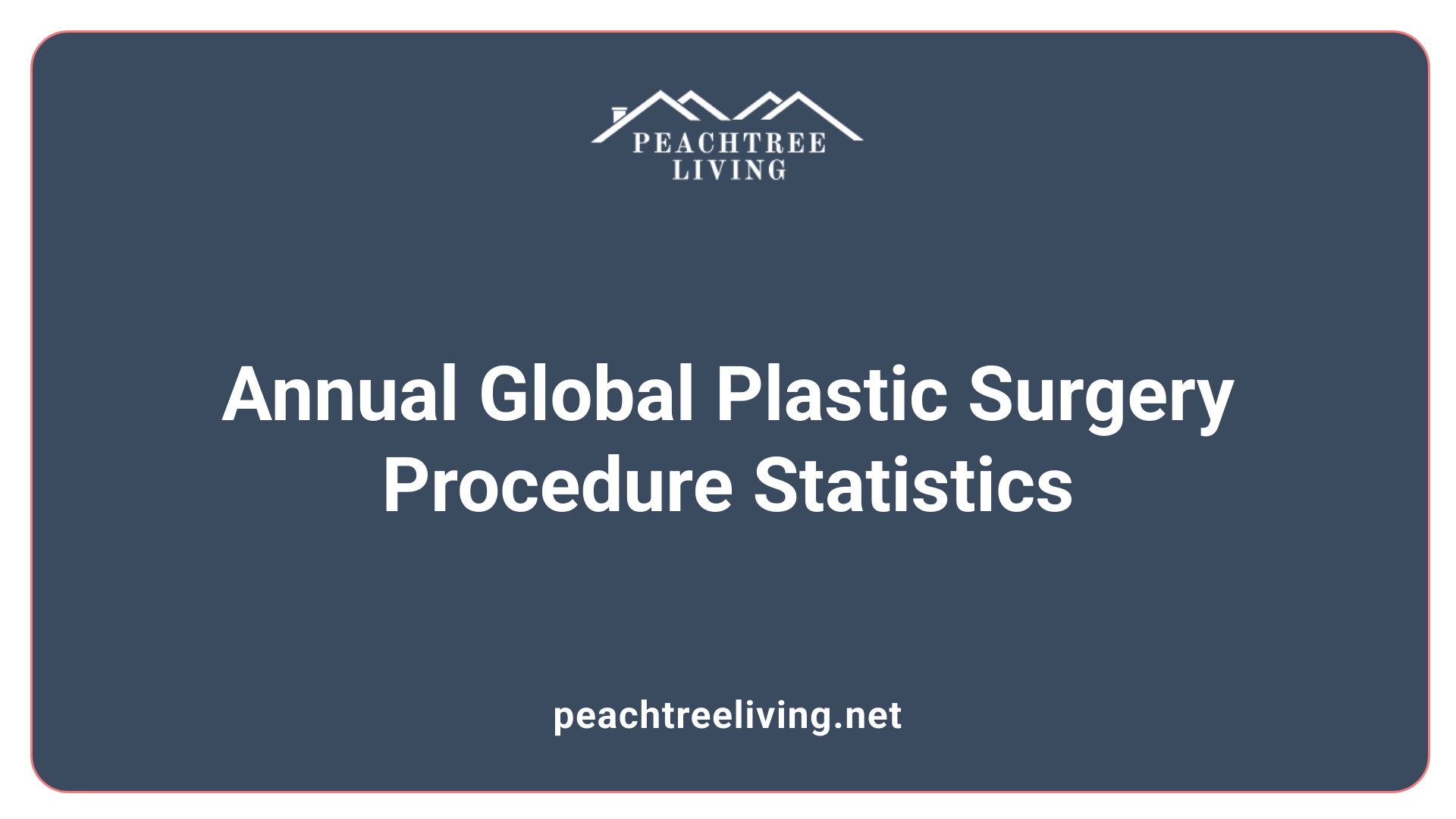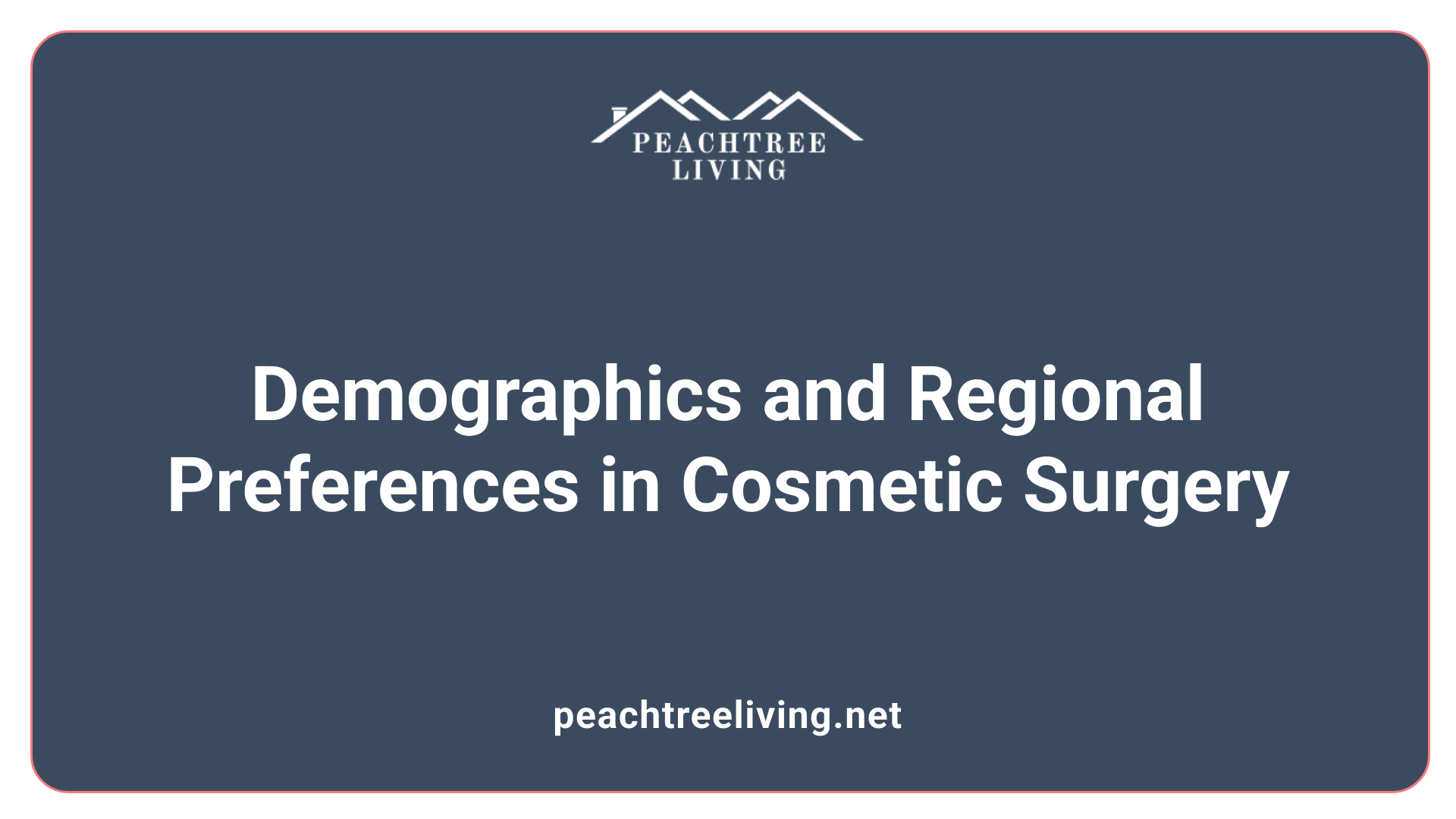Understanding the Dynamics of Aesthetic and Reconstructive Procedures
Plastic surgery has seen exponential growth over the past two decades, both in surgical and non-surgical treatments. As technological advances and shifting societal standards encourage more individuals to pursue aesthetic enhancement, the industry continues to evolve rapidly. This article delves into detailed statistics, regional trends, demographic shifts, and historical insights, providing a comprehensive overview of the current state of plastic surgery worldwide.
Most Common Plastic Surgery Procedures and Their Characteristics

What are the most common plastic surgery procedures?
The most frequently performed cosmetic surgeries worldwide include liposuction, breast augmentation, eyelid surgery, tummy tuck, and breast lift. Liposuction has maintained its position as the top surgical procedure globally for over 14 years, with over 2.2 million cases reported in 2023. Breast augmentation remains the most common for women, with around 2.2 million procedures annually, while procedures like rhinoplasty and blepharoplasty are highly popular for reshaping the nose and eyelids, respectively.
In different regions, preferences vary, for example, men often favor gynecomastia surgery (breast reduction) and eyelid surgery. Top procedures also include body contouring, such as Brazilian Butt Lifts, especially popular in the South Atlantic region of the United States.
Invasiveness and recovery period
Surgical procedures like liposuction, tummy tucks, and breast augmentations typically involve incisions and general anesthesia, with recovery times ranging from a few days to several weeks depending on the complexity. Liposuction, for instance, is one of the least invasive surgeries with a relatively short downtime.
On the other hand, non-surgical treatments such as Botox injections, hyaluronic acid fillers, and chemical peels are minimally invasive or non-invasive. They usually require little to no downtime, with patients returning to their daily routines immediately after treatments. These options are favored for their immediacy and low risk.
Popularity of non-surgical treatments
Non-surgical aesthetic treatments continue to grow in popularity. Botox remains the most used non-invasive procedure worldwide, with over 9 million injections performed in recent years. Hyaluronic acid fillers, hair removal, and skin tightening treatments also rank highly among preferred options due to their quick results and minimal side effects.
The trend reflects a growing demand for procedures that offer aesthetic benefits with less inconvenience and lower risk. These treatments appeal to individuals seeking subtle enhancements or maintenance between surgical procedures.
| Procedure Type | Examples | Popularity / Trends | Recovery Time | Regional Trends | Additional Details |
|---|---|---|---|---|---|
| Surgical | Liposuction, Breast Augmentation, Tummy Tuck, Eyelid Surgery | Continues to lead in popularity; liposuction most common for over 14 years | Days to weeks | Slight regional variations, e.g., South Atlantic high in Brazilian Butt Lifts | Involves incisions and anesthesia |
| Non-surgical | Botox, Dermal Fillers, Chemical Peels, Laser Treatments | Growing rapidly; Botox and fillers top worldwide | Usually none to a few hours | Consistently popular globally | Low risk, minimal downtime, immediate results |
This combination of surgical and non-surgical options provides diverse choices for individuals seeking aesthetic improvements, with trends trending towards less invasive procedures that still deliver effective results.
Global Trends and Growth in Plastic Surgery

What is the global trend in plastic surgery procedures?
In 2023, there was a notable 3.4% rise in the number of aesthetic procedures performed worldwide, reaching over 34.9 million surgeries and nonsurgical treatments. This continues a consistent upward trend over recent years, emphasizing the increasing popularity of cosmetic enhancements globally.
Advancements in technology, greater accessibility to procedures, and shifting societal perceptions about beauty and self-care have contributed to this growth. Countries like the United States and Brazil lead the industry, with millions of procedures performed annually.
How has plastic surgery demand changed since 2000?
Since 2000, the demand for plastic surgery has grown dramatically, with a total increase of approximately 115%. Key procedures such as buttock lifts and body contouring surgeries have seen explosive growth — over 250% and nearly 5,000%, respectively.
Nonsurgical options, including botulinum toxin and dermal fillers, have also surged, expanding by about 759% and 274%. This indicates a shift towards less invasive procedures that offer quick results and minimal downtime.
The COVID-19 pandemic played a role in accelerating this demand. During lockdown periods, many individuals invested in cosmetic procedures as part of renewed self-care routines or to address pandemic-related aesthetic concerns.
| Aspect | Data or Trend | Additional Details |
|---|---|---|
| Yearly procedure increases | 2023: 3.4% rise, 34.9 million global procedures | Steady growth driven by tech, social acceptance |
| Surgical vs. non-surgical | Over 15.8 million surgical; 19.1 million non-surgical in 2023 | Non-surgical growing faster, popular for immediate results |
| Long-term growth since 2000 | 115% increase overall | Significant rises in body procedures and minimally invasive options |
| Impact of COVID-19 | Surge in demand during and post-lockdowns | Pandemic prompted broader acceptance and pursuit of aesthetic treatments |
Overall, the plastic surgery industry continues to expand globally, with modern procedures aligning with patient preferences for safety, convenience, and natural-looking results.
Annual Surgical and Non-Surgical Procedure Volume

How many people undergo plastic surgery annually?
Based on the latest data, approximately 35 million aesthetic procedures were performed globally in 2023. This figure encompasses over 15.8 million surgical procedures and 19.1 million non-surgical treatments. The steady increase highlights a growing worldwide interest in aesthetic and reconstructive procedures across all age groups and regions.
Digital trends show that procedures like liposuction, breast augmentation, eyelid surgery, and tummy tucks remain highly popular, with regional hotspots including the South Atlantic, Mountain, and Pacific regions. The United States leads globally, performing more than 6 million procedures annually.
What are some interesting facts about the history of plastic surgery?
Plastic surgery dates back over 2,500 years, with early techniques originating in ancient India around 600 B.C., documented by Sushruta, known as the father of plastic surgery. Reconstructive methods were also practiced in ancient Egypt as early as 3000 B.C.
Modern advancements occurred during the World Wars, where surgeons refined techniques to repair war injuries, laying foundations for what we know today. Over centuries, innovations have made plastic surgery safer and more effective, increasing access and popularity.
Regional contributions and demographics
Major regions contributing to the global volume include the United States, which performs the highest total number of procedures, followed by Brazil, noted for its high rates of both surgical and non-surgical treatments. The demographics skew towards women, who account for around 85–94% of procedures, but the number of men seeking treatments has increased by over 18%, especially in facial surgeries.
In regions like Brazil and the U.S., preferences differ: women favor liposuction and breast procedures, while men show preference for gynecomastia and facial surgeries. Age-wise, the 40-54 age group remains the most active, while trends suggest a rising number of procedures among younger patients under 34.
| Region | Number of Procedures (Millions) | Notable Procedures | Gender Focus |
|---|---|---|---|
| United States | 6+ | Liposuction, breast augmentation, tummy tuck | Mostly women, growing male share |
| Brazil | High in surgical & non-surgical | Liposuction, Brazilian butt lift | Mostly women |
| Asia (Japan, etc.) | Significant | Rhinoplasty, eyelid surgery | Both genders, growing trend |
This data underscores how demographic preferences and regional appetites shape the landscape of plastic surgery, with safety emphasized through the importance of choosing board-certified surgeons.
Demographic and Regional Insights into Plastic Surgery

What is the demographic profile of plastic surgery patients?
Women remain the predominant demographic in the field of aesthetic plastic surgery, consistently comprising approximately 85-94% of patients across various years. Common procedures for women include liposuction, breast augmentation, and tummy tucks, underlining their preferences for body contouring and enhancement.
Men, although a smaller segment, are showing increasing interest, making up around 8-15% of all procedures. Popular among male patients are treatments such as gynecomastia surgery, eyelid procedures, and facial contouring. Age-related data indicates that individuals aged 40-54 are the most active group, representing nearly half of all patients. Adolescents and seniors also constitute significant segments, with teenagers seeking procedures like rhinoplasty and skin treatments, and older adults favoring eyelid surgeries and face lifts.
Which regions lead in performing plastic surgery?
The United States stands out as the dominant region, performing more than 7.4 million procedures in 2022 alone. This represents about a quarter of the global total and is facilitated by a large base of board-certified plastic surgeons. Brazil follows as the second-largest market with approximately 3.3 million procedures, largely driven by regional aesthetic trends and a high density of practitioners.
Regionally within the United States, the South Atlantic region reports the highest volume of procedures. Popular treatments here include Brazilian Butt Lifts and liposuction, reflecting regional aesthetic preferences.
Other regions like the Mountain and Pacific areas also report significant procedure numbers, influenced by cultural attitudes toward cosmetic enhancement and the availability of advanced surgical facilities.
Overall, local cultural norms, economic factors, and access to qualified surgeons shape regional differences in procedure types and volumes.
| Region/Country | Approximate Procedures (millions) | Notable Procedures | Influencing Factors |
|---|---|---|---|
| United States | 7.4 | Liposuction, breast augmentation | Large surgeon base, cultural demand |
| Brazil | 3.3 | Liposuction, breast surgery | High aesthetic emphasis, population |
| Japan | Top ranking among Asian countries | Eye and facial procedures | Cultural beauty standards |
This geographical distribution highlights how demographic profiles and regional preferences intersect to shape global trends in cosmetic surgery.
Economic, Ethical, and Industry Aspects
What are the costs associated with plastic surgery?
The expenses for plastic surgery procedures can vary significantly depending on the type of treatment and geographic location. Surgical procedures such as breast augmentation, facelifts, or tummy tucks typically cost several thousand dollars, with average surgeon fees often exceeding $10,000. Non-surgical treatments like Botox, dermal fillers, or lip augmentation are generally less expensive, usually billed per session, and tend to be more accessible to a broader demographic.
Regional disparities also influence pricing, with some areas offering more affordable options while others, such as major cities or regions with higher living costs, may charge premium rates. Due to these variations, it’s crucial for patients to prioritize safety and ensure their chosen provider is qualified and board-certified.
Why is the importance of board certification emphasized?
Choosing a board-certified plastic surgeon is vital for safety and achieving satisfactory results. Certified practitioners have undergone rigorous training, adhere to strict ethical standards, and stay updated with the latest advancements in the field. Reputable organizations like the American Society of Plastic Surgeons (ASPS) emphasize that patients should seek surgeons who meet these higher standards to minimize risks like complications or subpar outcomes.
How is industry growth projected?
The plastic surgery sector is experiencing steady expansion driven by technological innovations, social acceptance, and an increase in disposable income. Global data predicts an industry growth rate of approximately 7.8% annually, reaching an estimated USD 10 billion by 2032. Growth factors include the rising popularity of minimally invasive treatments, expanding medical tourism, and a broader demographic opting for aesthetic procedures.
Despite economic uncertainties, interest in aesthetic procedures remained stable in 2024, reflecting the resilience of the industry. Ethical practices and the use of qualified, board-certified surgeons are essential elements that support sustainable industry growth.
| Aspect | Data | Details |
|---|---|---|
| Procedure Costs | Varies | $3,000 to over $10,000 for surgeries; less for non-surgical treatments |
| Industry Growth | 7.8% CAGR | USD 10 billion projected by 2032 |
| Certification | Critical | Ensures safety and quality, recommended by ASPS |
| Key Drivers | Technology, acceptance, income | Expand access and demand for procedures |
Looking Forward: The Future of Plastic Surgery
As cultural attitudes towards beauty continue to evolve and technology advances further, the plastic surgery landscape is expected to expand both in scope and accessibility. The industry’s growth highlights the increasing desire for self-improvement but also underscores the importance of safety, qualified practitioners, and ethical standards. Future trends will likely see more personalized procedures, minimally invasive techniques, and a broader demographic embracing aesthetic treatments. Staying informed and choosing certified professionals will remain essential for safe and satisfying outcomes.
References
- Plastic Surgery Statistics - American Society of Plastic Surgeons
- Plastic Surgery Statistics 2024 - American Society of Plastic Surgeons
- Global Survey 2023: Full Report and Press Releases - ISAPS
- Cosmetic surgery - Statistics & Facts | Statista
- Trends in Surgical and Nonsurgical Aesthetic Procedures - PubMed
- Aesthetic Society Procedural Statistics
- Plastic Surgery Statistics In USA
- Cosmetic Surgery Boom | The British Association of Aesthetic Plastic ...

